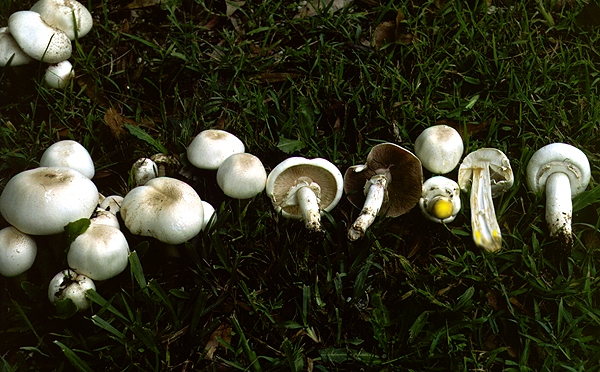
Agaricus xanthodermus Genev.
 |
Common name: The Yellow Stainer (in Europe) due to the yellow stains that appear if the fungus is bruised.
Description: This mushroom produces very large caps 812 cm in diameter (sometimes up to 15 cm). The caps are convex, white and smooth, although there are some forms that have fine scales. The margins often have white fragments of the veil still attached as a ragged fringe. The flesh is thick and white and smells unpleasantly of phenol, iodine or indian ink. It stains yellow when cut, especially at the base of the stem where it becomes brilliant yellow-orange. The gills are at first protected by a white, membranous veil which breaks away as the cap expands to leave the marginal fragments and a pendulous ring on the stem. The free gills are at first white or greyish, then become pinkish or reddish and finally very dark purple-brown or chocolate-brown. The stem is usually about 812 cm long (sometimes up to 15 cm) and 12.5 cm thick; it is white with a pendulous, membranous ring attached about two-thirds of the way up the stem. The stem is usually hollow with age and has a swelling at the base of the stem. All parts of the cap and stem surface become yellow when rubbed or bruised.
The spores measure 56.5 × 3.54.5 µm and are ellipsoidal, smooth and bronze under the microscope but chocolate-brown in mass.
Substratum: Agaricus xanthodermus occurs on humus-rich or composted soil in sheltered locations, often at forest margins. It usually occurs in small groups or clusters.
Distribution: Known from Queensland, New South Wales, Victoria, Tasmania, South Australia and Western Australia.
Notes: Agaricus xanthodermus is poisonous, although past records indicate that some people have eaten it without ill effects. The species is known to contain the toxin phenol and its apparent edibility for some people simply indicates a higher tolerance to the toxin. The phenolic/iodine smell present in the fresh material becomes extremely strong as the fungus is cooked, and even one specimen in a dish of field mushrooms is sufficient to create unpleasant odours. The fungus has gastro-irritant qualities leading to a variety of stomach upsets. However, most people who accidentally eat this species recover rapidly after the initial period of discomfort which may include nausea and vomiting. It is frequently found in eastern Australia and may occur on garden lawns. The sight of large quantities of apparently beautiful mushrooms has caused many people to mistakenly eat this species. During the fungus season, most Australian poisons centres can count on having at least one case involving ingestion of this species.
